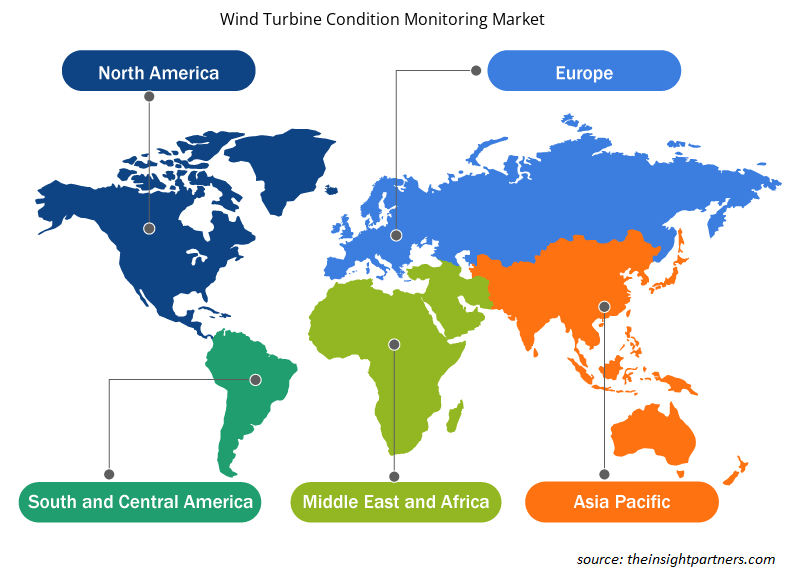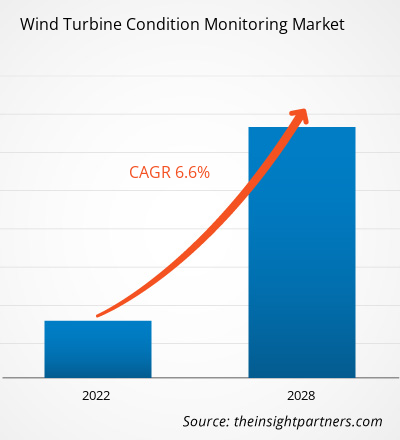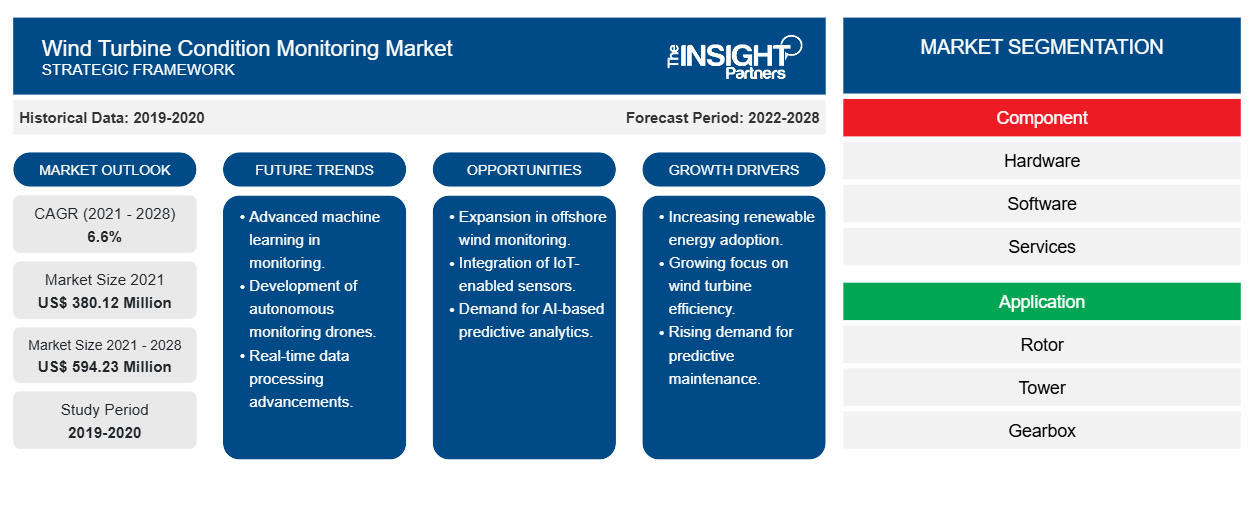Se espera que el mercado de monitoreo del estado de las turbinas eólicas crezca de US$ 380,12 millones en 2021 a US$ 594,23 millones en 2028; se estima que crecerá a una CAGR del 6,6% durante 2021 a 2028.
La necesidad de reducir las emisiones de gases de efecto invernadero y aumentar la cantidad de energía renovable en la combinación energética impulsó el desarrollo de parques eólicos marinos. Ha habido un movimiento considerable hacia la energía renovable y verde en el sector energético para reducir las emisiones de carbono, agotar los combustibles fósiles, el cambio climático y otros. Esto está impulsando el crecimiento del mercado de monitoreo del estado de las turbinas eólicas.
La demanda de energía renovable seguirá aumentando debido a la caída de los costos de la tecnología, la creciente necesidad de reducir las emisiones de CO2 y el aumento del consumo de energía en los países en desarrollo y subdesarrollados. Según la Agencia Internacional de Energías Renovables (IRENA), la proporción de energías renovables en la generación anual de energía global debe aumentar del 25% al 86% para 2050, y el mundo necesitará invertir 110 billones de dólares estadounidenses en el sector para 2050, frente a los 95 billones de dólares estadounidenses esperados para 2030. Como resultado, habrá un cambio notable desde los combustibles fósiles y las fuentes de energía renovables. En Europa, hay muchos proyectos de molinos de viento marinos en funcionamiento, que representan el 90% de la generación total de energía. Esto está impulsando aún más el crecimiento del mercado de monitoreo de condición de turbinas eólicas
La creciente inclinación hacia la energía limpia renovable es un factor impulsor significativo para el crecimiento del mercado de monitoreo de condición de turbinas eólicas en todo el mundo. El mercado de monitoreo de condición de turbinas eólicas es maduro en las naciones desarrolladas y está creciendo sustancialmente en muchos países en desarrollo. Debido a la alta producción y expansión a largo plazo de los parques eólicos, la instalación de turbinas eólicas marinas está en aumento. Además, la creciente población mundial y el aumento de los ingresos disponibles en los países en desarrollo están impulsando el consumo de energía. Sin embargo, el crecimiento del mercado de monitoreo de condición de turbinas eólicas se ve obstaculizado por el alto costo de las instalaciones de parques eólicos marinos. El sistema de monitoreo de condición de turbina eólica facilita una flexión precisa del eje, la firma o perfil del eje, la vibración torsional del eje, el torque del eje, las rpm del eje y la medición de potencia del eje. Estos sistemas se utilizan ampliamente para la detección temprana de fallas o fallas y también ayudan a maximizar la productividad y minimizar el tiempo de inactividad, aumentando así el crecimiento del mercado de monitoreo de condición de turbinas eólicas.
Personalice este informe según sus necesidades
Obtendrá personalización en cualquier informe, sin cargo, incluidas partes de este informe o análisis a nivel de país, paquete de datos de Excel, así como también grandes ofertas y descuentos para empresas emergentes y universidades.
- Obtenga las principales tendencias clave del mercado de este informe.Esta muestra GRATUITA incluirá análisis de datos, desde tendencias del mercado hasta estimaciones y pronósticos.
Impacto de la pandemia de COVID-19 en el mercado de monitoreo del estado de las turbinas eólicas
América del Norte tiene la tasa más alta de adopción de tecnología avanzada debido a políticas gubernamentales favorables que fomentan la innovación y mejoran las capacidades de infraestructura. La pandemia de COVID-19 tuvo varias implicaciones para el sector de energía renovable en la región. Las instalaciones de generación de energía eólica redujeron su actividad, incluido el cierre de proyectos de construcción, operaciones y mantenimiento en varias ubicaciones, debido a las implicancias del confinamiento. En toda la industria de la energía eólica, estas medidas de cuarentena y cierres provocaron licencias y despidos de personal técnico, de construcción y de fabricación, así como desmovilizaciones de proyectos en muchos casos. Como resultado, muchos parques solares y eólicos lucharon por mantenerse al día con el mantenimiento y las operaciones. Además, la pandemia de COVID-19 dificultó a los productores de energía renovable obtener financiación para proyectos o capital social. Como resultado, la pandemia de COVID-19 influyó negativamente en el mercado de monitoreo del estado de las turbinas eólicas de América del Norte.
Perspectivas del mercado de monitoreo del estado de las turbinas eólicas
Avance tecnológico en la fabricación y el monitoreo de turbinas eólicas
Las palas más largas y las torres más altas, dos de los aspectos más críticos para aumentar la productividad de las turbinas eólicas, están impulsando el esfuerzo de investigación y desarrollo de próxima generación para crear una turbina más potente, eficiente, duradera y rentable. Otros avances significativos incluyen la creación de turbinas inteligentes que recopilan y comprenden datos en tiempo real y el modelado y ajuste de los flujos de las plantas eólicas y los diseños de las turbinas para optimizar la cosecha de viento. La Oficina de Tecnologías de Energía Eólica (WETO) colabora con la industria para mejorar el rendimiento y la confiabilidad de las tecnologías eólicas de próxima generación al tiempo que reduce los costos de la energía eólica. Además, la Oficina de Tecnologías de Energía Eólica y la Oficina de Fabricación Avanzada del Departamento de Energía de EE. UU. están colaborando con grupos públicos y privados para utilizar la fabricación aditiva, también conocida como impresión 3D , para producir moldes de palas de turbinas eólicas. El método tradicional de diseño de palas requiere el desarrollo de un tapón, o un modelo a escala real de la pala terminada, que luego se utiliza para crear el molde. El tapón es una de las operaciones que más tiempo y mano de obra requieren en la fabricación de palas de turbinas eólicas. Por lo tanto, la impresión 3D ahorra estos valiosos recursos. La tecnología de la industria eólica debe seguir avanzando para garantizar el crecimiento futuro de la industria, aprovechando los logros anteriores para mejorar la fiabilidad, impulsar los factores de capacidad y reducir los costes. Las turbinas eólicas modernas son cada vez más rentables y estables, y sus potencias nominales han aumentado hasta alcanzar niveles de varios megavatios. Por tanto, los avances tecnológicos y la modernización crecientes en el sistema de monitorización del estado de las turbinas eólicas crearán numerosas oportunidades de mercado.WETO) collaborates with the industry to improve the performance and dependability of next-generation wind technologies while lowering wind energy costs. Further, the Wind Energy Technologies Office and the Advanced Manufacturing Office of the US Department of Energy are collaborating with public and private groups to use additive manufacturing, also known as
Información del mercado basada en componentes
Según los componentes, el mercado de monitorización del estado de las turbinas eólicas se segmenta en hardware, software y servicios. El anemómetro, el sensor de desplazamiento, los sistemas de adquisición de datos y el acelerómetro se utilizan ampliamente para monitorizar el estado de las turbinas eólicas. Las herramientas de monitorización del estado ayudan a controlar el estado de los componentes de las turbinas eólicas y los sistemas eléctricos asociados. Estas herramientas ayudan a los operadores y propietarios de parques eólicos a sustituir componentes siempre que sea necesario, prediciendo problemas de mantenimiento. Por ejemplo, KK Wind Solutions ofrece unidades versátiles de adquisición y análisis de datos que se pueden colocar en la góndola de la turbina eólica. Estas unidades de adquisición y análisis de datos recogen datos de varios acelerómetros y sensores conectados y transfieren la información analizada. Los sistemas de monitorización del estado basados en vibraciones se encuentran entre los sistemas más establecidos que se utilizan para monitorizar el tren de transmisión de las turbinas eólicas. Los sensores utilizados para la monitorización del estado basada en vibraciones incluyen transductores de velocidad, acelerómetros y transductores de desplazamiento o distancia.
Perspectivas de mercado basadas en aplicaciones
Según la aplicación, el mercado de monitoreo de estado de turbinas eólicas se segmenta en rotor, torre, caja de cambios, generador y otros. La función básica de la caja de cambios en la turbina eólica es transferir energía del rotor al generador. Debido al frenado frecuente y a las velocidades variables del viento, la carga fluctúa, lo que provoca un gran desgaste en las partes móviles. Los componentes de la caja de cambios de la turbina eólica generalmente se monitorean con sensores de vibración. Como la resonancia de los cojinetes es particularmente en multi-kHz, generalmente se sugieren sensores de vibración que funcionan en el rango de alrededor de 10 kHz y más para monitorear los ejes de alta y baja velocidad. El sistema de monitoreo de estado de turbina eólica de referencia está diseñado para detectar y prevenir fallas en la caja de cambios. Con un monitoreo y análisis precisos en tiempo real, se pueden consultar los cronogramas del personal y se pueden realizar reparaciones en una etapa temprana, lo que ayuda a ahorrar costos. Suecia es líder mundial en materia de descarbonización, ya que aspira a ser carbono neutral para 2045, y el sector energético aspira a generar electricidad 100% renovable para 2040. La contribución de la energía eólica está aumentando de forma constante en el país, ya que el objetivo del país es aprovechar 50 TWh de energía eólica para 2024. Por tanto, la creciente inclinación hacia la energía renovable acelera la necesidad de sensores de vibración respectivos.
Los actores que operan en el mercado de monitoreo del estado de las turbinas eólicas adoptan estrategias como fusiones, adquisiciones e iniciativas de mercado para mantener sus posiciones en el mercado. A continuación, se enumeran algunos desarrollos de los actores clave:
- En 2022, el Consorcio Nacional de Investigación y Desarrollo de Energía Eólica Marina (NOWRDC) ha adjudicado dos proyectos de investigación de GE: uno centrado en establecer una técnica de unión robusta para piezas de hierro de gran tamaño y otro en el uso de un buque de inspección autónomo (AIV) para turbinas eólicas marinas.
Perspectivas regionales del mercado de monitoreo del estado de las turbinas eólicas
Los analistas de Insight Partners explicaron en detalle las tendencias y los factores regionales que influyen en el mercado de monitoreo del estado de las turbinas eólicas durante el período de pronóstico. Esta sección también analiza los segmentos y la geografía del mercado de monitoreo del estado de las turbinas eólicas en América del Norte, Europa, Asia Pacífico, Medio Oriente y África, y América del Sur y Central.

- Obtenga datos regionales específicos para el mercado de monitoreo del estado de las turbinas eólicas
Alcance del informe de mercado sobre monitoreo del estado de las turbinas eólicas
| Atributo del informe | Detalles |
|---|---|
| Tamaño del mercado en 2021 | US$ 380,12 millones |
| Tamaño del mercado en 2028 | US$ 594,23 millones |
| CAGR global (2021-2028) | 6,6% |
| Datos históricos | 2019-2020 |
| Período de pronóstico | 2022-2028 |
| Segmentos cubiertos | Por componente
|
| Regiones y países cubiertos | América del norte
|
| Líderes del mercado y perfiles de empresas clave |
|
Densidad de actores del mercado: comprensión de su impacto en la dinámica empresarial
El mercado de monitoreo del estado de las turbinas eólicas está creciendo rápidamente, impulsado por la creciente demanda de los usuarios finales debido a factores como la evolución de las preferencias de los consumidores, los avances tecnológicos y una mayor conciencia de los beneficios del producto. A medida que aumenta la demanda, las empresas amplían sus ofertas, innovan para satisfacer las necesidades de los consumidores y aprovechan las tendencias emergentes, lo que impulsa aún más el crecimiento del mercado.
La densidad de actores del mercado se refiere a la distribución de las empresas o firmas que operan dentro de un mercado o industria en particular. Indica cuántos competidores (actores del mercado) están presentes en un espacio de mercado determinado en relación con su tamaño o valor total de mercado.
Las principales empresas que operan en el mercado de monitoreo del estado de las turbinas eólicas son:
- Advantech Co. Ltd
- Grupo ENVISION
- Compañía Baker Hughes
- NERCON GmbH
- Goldwind.com
Descargo de responsabilidad : Las empresas enumeradas anteriormente no están clasificadas en ningún orden particular.

- Obtenga una descripción general de los principales actores clave del mercado de monitoreo del estado de las turbinas eólicas
El mercado mundial de monitoreo del estado de las turbinas eólicas está segmentado en función de los componentes y la aplicación. Según los componentes, el mercado de monitoreo del estado de las turbinas eólicas se segmenta en hardware, software y servicios. Según la aplicación, el mercado de monitoreo del estado de las turbinas eólicas se segmenta en rotor, torre, caja de cambios, generador y otros.
Advantech Co. Ltd., Baker Hughes Company, ENVISION Group, ENERCON GmbH, goldwind.com, General Electric, NORDEX SE, Siemens Gamesa Renewable Energy, TÜV Rheinland y Vestas son algunos de los actores clave del mercado de monitoreo del estado de las turbinas eólicas considerados para el estudio de investigación. Además, en este informe de investigación se han estudiado y analizado varios otros actores importantes del mercado de monitoreo del estado de las turbinas eólicas para obtener una visión holística del mercado global de monitoreo del estado de las turbinas eólicas y su ecosistema.
- Análisis histórico (2 años), año base, pronóstico (7 años) con CAGR
- Análisis PEST y FODA
- Tamaño del mercado, valor/volumen: global, regional y nacional
- Industria y panorama competitivo
- Conjunto de datos de Excel
Informes recientes
Informes relacionados
Testimonios
Razón para comprar
- Toma de decisiones informada
- Comprensión de la dinámica del mercado
- Análisis competitivo
- Información sobre clientes
- Pronósticos del mercado
- Mitigación de riesgos
- Planificación estratégica
- Justificación de la inversión
- Identificación de mercados emergentes
- Mejora de las estrategias de marketing
- Impulso de la eficiencia operativa
- Alineación con las tendencias regulatorias























 Obtenga una muestra gratuita para - Mercado de monitoreo del estado de las turbinas eólicas
Obtenga una muestra gratuita para - Mercado de monitoreo del estado de las turbinas eólicas